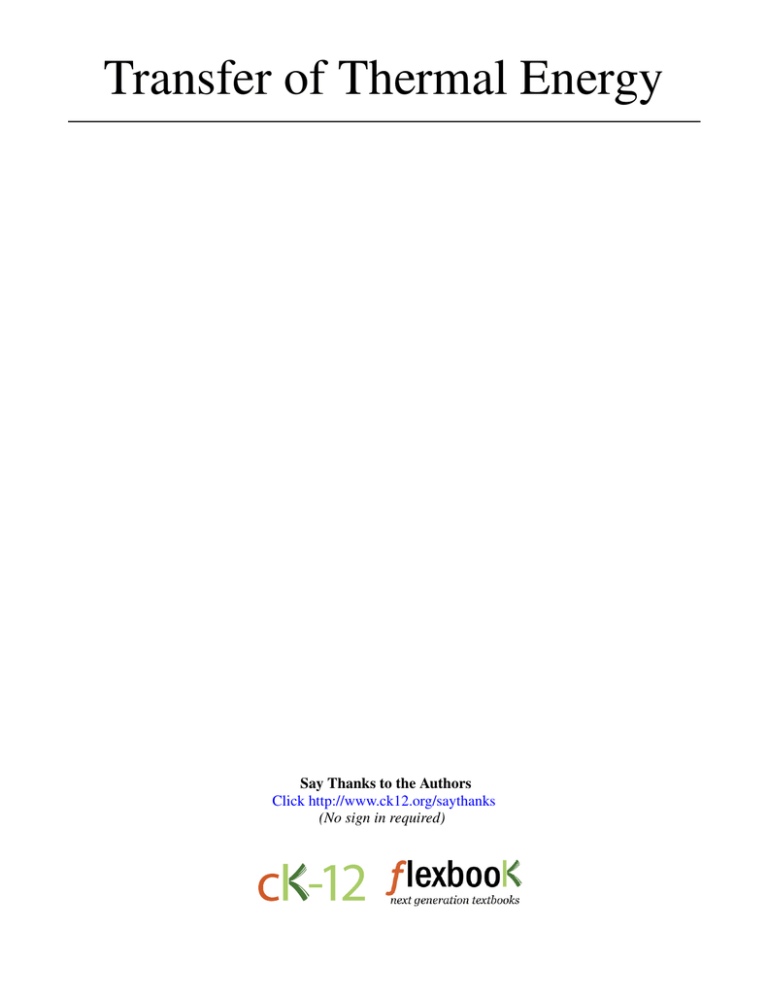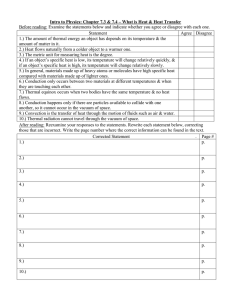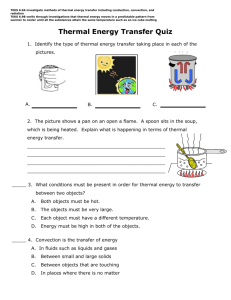Transfer of Thermal Energy Say Thanks to the Authors Click
advertisement

Transfer of Thermal Energy Say Thanks to the Authors Click http://www.ck12.org/saythanks (No sign in required) To access a customizable version of this book, as well as other interactive content, visit www.ck12.org CK-12 Foundation is a non-profit organization with a mission to reduce the cost of textbook materials for the K-12 market both in the U.S. and worldwide. Using an open-content, web-based collaborative model termed the FlexBook®, CK-12 intends to pioneer the generation and distribution of high-quality educational content that will serve both as core text as well as provide an adaptive environment for learning, powered through the FlexBook Platform®. Copyright © 2014 CK-12 Foundation, www.ck12.org The names “CK-12” and “CK12” and associated logos and the terms “FlexBook®” and “FlexBook Platform®” (collectively “CK-12 Marks”) are trademarks and service marks of CK-12 Foundation and are protected by federal, state, and international laws. Any form of reproduction of this book in any format or medium, in whole or in sections must include the referral attribution link http://www.ck12.org/saythanks (placed in a visible location) in addition to the following terms. Except as otherwise noted, all CK-12 Content (including CK-12 Curriculum Material) is made available to Users in accordance with the Creative Commons Attribution-Non-Commercial 3.0 Unported (CC BY-NC 3.0) License (http://creativecommons.org/ licenses/by-nc/3.0/), as amended and updated by Creative Commons from time to time (the “CC License”), which is incorporated herein by this reference. Complete terms can be found at http://www.ck12.org/terms. Printed: September 30, 2014 www.ck12.org C HAPTER Chapter 1. Transfer of Thermal Energy 1 Transfer of Thermal Energy Lesson 18.2: True or False Name___________________ Class______________ Date__________ Determine if the following statements are true or false. _____ 1. Conduction occurs only between particles that collide. _____ 2. Wood is an example of a good thermal conductor. _____ 3. Home insulation prevents the transfer of cold into the house. _____ 4. Warmer air rises because it is less dense than cooler air. _____ 5. All objects radiate thermal energy. _____ 6. Convection currents carry thermal energy from the sun to Earth. _____ 7. Fluid particles with more energy have greater density. _____ 8. Metals are excellent thermal conductors because they have freely moving electrons. _____ 9. A land breeze is an example of a convection current. _____ 10. Thermal energy is transferred from a space heater to a person in front of it by conduction. Lesson 18.2: Critical Reading Name___________________ Class______________ Date__________ Read this passage from the text and answer the questions that follow. Convection Convection is the transfer of thermal energy by particles moving through a fluid. Particles transfer energy by moving from warmer to cooler areas. That’s how energy is transferred through soup in a pot on a hot stove. Particles of soup near the bottom of the pot get hot first. They have more energy so they spread out and become less dense. With lower density, these particles rise to the top of the pot. By the time they reach the top of the pot, they have transferred their thermal energy and cooled. They have less energy to move apart, so they become denser. With greater density, the particles sink to the bottom of the pot, and the cycle repeats. This loop of moving particles is called a convection current. Convection currents move thermal energy through many fluids, including molten rock inside Earth, water in the oceans, and air in the atmosphere. Questions 1. What is convection? 2. Describe how convection currents transfer thermal energy throughout a pot of soup on a stovetop. 3. Give other examples of fluids in which thermal energy is transferred by convection currents. 1 www.ck12.org Lesson 18.2: Multiple Choice Name___________________ Class______________ Date__________ Circle the letter of the correct choice. 1. A pot resting on a hot stovetop heats up because of a. b. c. d. convection. conduction. radiation. all of the above 2. Your hand feels cold when you hold an ice cube because a. b. c. d. the ice radiates cold to your hand. the ice conducts cold to your hand. your hand cools down by convection. your hand transfers thermal energy to the ice. 3. In which of the following materials does conduction occur most quickly? a. b. c. d. iron wood plastic oxygen 4. Examples of thermal insulators include a. b. c. d. down feathers. Styrofoam. air. all of the above 5. The transfer of thermal energy by convection occurs only in a. b. c. d. gases. solids. fluids. liquids. 6. Thermal energy is transferred throughout the ocean by a. b. c. d. radiation. conduction. thermal conductors. convection currents. 7. A sea breeze blows a. b. c. d. toward the land. toward the sea. only at night. during both day and night. Lesson 18.2: Matching Name___________________ Class______________ Date________ 2 www.ck12.org Chapter 1. Transfer of Thermal Energy Match each definition with the correct term. Definitions _____ 1. material that allows little if any conduction of thermal energy _____ 2. transfer of thermal energy by waves that can travel through space _____ 3. flow of particles in a fluid due to differences in temperature and density _____ 4. material that is good at transferring thermal energy by conduction _____ 5. amount of mass in a given volume of matter _____ 6. transfer of thermal energy between particles of matter that are touching _____ 7. transfer of thermal energy by particles moving through a fluid Terms a. conduction b. thermal conductor c. convection d. thermal insulator e. radiation f. convection current g. density Lesson 18.2: Fill in the Blank Name___________________ Class______________ Date________ Fill in the blank with the appropriate term. 1. 2. 3. 4. 5. 6. 7. When you hold a hot object, thermal energy is transferred from the object to your hands by __________. Cooking pots are made of metals because metals are excellent thermal __________. Cooking pot handles are often made of plastic because plastic is a good thermal __________. Particles of a fluid that have the greatest kinetic energy have the __________ density. Convection currents in Earth’s atmosphere create __________. Thermal energy is transferred from a campfire to nearby people by __________. __________ is the only way of transferring thermal energy that doesn’t require matter. Lesson 18.2: Critical Writing Name___________________ Class______________ Date________ Thoroughly answer the question below. Use appropriate academic vocabulary and clear and complete sentences. Why does conduction work better in solids whereas convection works only in gases and liquids? 3







